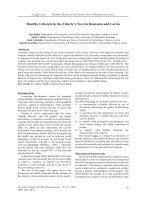CORONARY ANGIOGRAPHY – THE NEED FOR IMPROVEMENT IN MEDICAL AND INTERVENTIONAL THERAPY pot
Bạn đang xem bản rút gọn của tài liệu. Xem và tải ngay bản đầy đủ của tài liệu tại đây (23.19 MB, 218 trang )
CORONARY ANGIOGRAPHY
– THE NEED FOR
IMPROVEMENT IN
MEDICAL AND
INTERVENTIONAL THERAPY
Edited by Branislav Baškot
Coronary Angiography –
The Need for Improvement in Medical and Interventional Therapy
Edited by Branislav Baškot
Published by InTech
Janeza Trdine 9, 51000 Rijeka, Croatia
Copyright © 2011 InTech
All chapters are Open Access articles distributed under the Creative Commons
Non Commercial Share Alike Attribution 3.0 license, which permits to copy,
distribute, transmit, and adapt the work in any medium, so long as the original
work is properly cited. After this work has been published by InTech, authors
have the right to republish it, in whole or part, in any publication of which they
are the author, and to make other personal use of the work. Any republication,
referencing or personal use of the work must explicitly identify the original source.
Statements and opinions expressed in the chapters are these of the individual contributors
and not necessarily those of the editors or publisher. No responsibility is accepted
for the accuracy of information contained in the published articles. The publisher
assumes no responsibility for any damage or injury to persons or property arising out
of the use of any materials, instructions, methods or ideas contained in the book.
Publishing Process Manager Iva Simcic
Technical Editor Teodora Smiljanic
Cover Designer Jan Hyrat
Image Copyright BioMedical, 2011. Used under license from Shutterstock.com
First published August, 2011
Printed in Croatia
A free online edition of this book is available at www.intechopen.com
Additional hard copies can be obtained from
Coronary Angiography – The Need for Improvement in Medical
and Interventional Therapy, Edited by Branislav Baškot
p. cm.
ISBN 978-953-307-641-6
free online editions of InTech
Books and Journals can be found at
www.intechopen.com
Contents
Preface IX
Chapter 1 Primary Percutaneous Coronary Intervention
for ST–Elevation Myocardial Infarction and
Door-to-Balloon Time: A Catheterization
Laboratory Perspective 1
Darryl D. Prime and Robert J. Applegate
Chapter 2 Risk Stratification and
Invasive Strategy in NSTE-ACS 17
Frantisek Kovar, Milos Knazeje and Marian Mokan
Chapter 3 Trans Radial Access for Diagnostic Coronary
Angiography and Percutaneous Coronary Interventions:
Current Concepts and Future Challenges 51
Deepak Natarajan
Chapter 4 An Infected Drug-Eluting Stented
Coronary Aneurysm Forming Intracardiac Fistula 75
Ken Kishida
Chapter 5 Acute Coronary Syndromes in Women -
Gender Specific Changes in Coronarography 81
Anna Polewczyk, Marianna Janion and Maciej Polewczyk
Chapter 6 Tako-Tsubo Cardiomyopathy:
A Recent Clinical Syndrome Mimicking
an Acute Coronary Syndrome 103
Montassier Emmanuel, Segard Julien,
Arnaud Martinage, Nicolas Piriou, Philippe Le Conte,
Gilles Potel
and Jean Pierre Gueffet
Chapter 7 Role of Percutaneous Cardiopulmonary Support
(PCPS) in Patients with Unstable Hemodynamics During
the Peri-Coronary-Intervention Period 131
Ho-Ki Min and Young Tak Lee
VI Contents
Chapter 8 Coronary Angiography Before
and After Renal Transplantation 147
Mihas Kodenchery, Samrat Bhat, Mohamed El-Ghoroury,
Hiroshi Yamasaki and Peter A. McCullough
Chapter 9 Coronary Interventions with
Mechanical Circulatory Support 159
Markus Ferrari
Chapter 10 Coronary Arteriovenous Fistula 165
Recep Demirbag
Chapter 11 Association Between Fatty Liver and Cardiovascular Disease:
Mechanism and Clinical Implications 189
Nseir W. and Assy N.
Preface
The mortality from ischemic heart disease has decreased in recent years. The better
understanding of risk factors associated with development of coronary artery disease
(CAD) has significantly contributed to this decline. Preventive measures such as
aggressive therapy of arterial hypertension, diabetes mellitus, and lipid disorders and
by campaigning against the smoking are important components of this medical
success. Furthermore, improvements in medical and interventional therapy have
reduced the complications associated with acute myocardial infarction as well as
revascularization.
Interventional cardiology is a branch of cardiology and Andreas Gruentzig is
considered the father of interventional cardiology after the development of
angioplasty by interventional radiologist Dr Charles Dotter. As we know,
interventional procedures have been complicated by restenosis due to the formation of
endothelial tissue overgrowth at the lesion site. Restenosis is the body’s response to
the injury of the vessel wall from angioplasty and to stent as a foreign body. As
opposed to bare metal stent, drug eluting stents are covered with a medicine that is
slowly dispersed with the goal of suppressing the restenosis reaction. One of the
newest innovations in coronary stents is the development of a dissolving stent. Abbott
laboratory has used a dissolvable material, polilactic acid that will completely absorb
within two years of being implanted. Other key changes happened along the way.
Perhaps the most important changes were a modification in mindset so that physicians
demonstrated that they could successfully work less invasively within the vascular
three. This changes leads to the development of invasive electrophysiologic
procedures, such as mapping and ablation, percutaneous application of technology to
treat valvular heart disease, and application of percutaneous technologies to treat
peripheral arterial disease, and now cerebrovascular disease. Percutaneous methods
initially introduced by interventional cardiologists should become the treatment of
choice for a multiplicity of cardiovascular conditions.
But we also examined in this book a periprocedural complication of coronary
angiography, and coronary intervention. That includes related to cardiac catheterization
and diagnostic coronary angiography, and those that occur as a consequence of the
specific equipment. However, improvements in devices, the use of stents, and aggressive
antiplatelet therapy have significantly reduced the incident of major periprocedural
X Preface
complications, and as an example, the need of emergent coronary artery bypass surgery
decreased from 1.5 % in early 90, to 0.14% after 2000 year.
This book should prove to be useful reference for cardiologists, radiologists, nuclear
medicine physicians, anesthesiologists, cardiac surgeons, internists and basis
scientists, their trainees and medical students who have an interest in this field either
from the technical aspects or from clinical viewpoint.
Branislav Baškot MD PhD Ass Prof
Department of Nuclear Medicine Imaging
“Dr Baskot” Belgrade, Serbia
1
Primary Percutaneous Coronary Intervention
for ST–Elevation Myocardial Infarction and
Door-to-Balloon Time: A Catheterization
Laboratory Perspective
Darryl D. Prime and Robert J. Applegate
Wake Forest School of Medicine
United States of America
1. Introduction
Rapid reperfusion improves mortality in patients with acute ST- elevation myocardial
infarction (STEMI). Moreover, achieving reperfusion by primary percutaneous coronary
intervention (PCI) instead of fibrinolytic therapy is preferred because patients have less
strokes, less nonfatal reinfarctions, and a lower mortality rate (Keeley et al., 2003). However,
because achieving perfusion with primary PCI sometimes involves transporting patients from
the location where the diagnosis was made to a catheterization laboratory, and once in the
catheterization laboratory numerous technical and clinical problems must be successfully
managed, there is a significant time delay. In some studies, this time delay has been associated
with an increased mortality (Boersma, 2006; Nallamothu and Bates, 2003). Furthermore, the
advantages of primary PCI over thrombolytic therapy may be negated if the time to
reperfusion with primary PCI exceeds that of fibrinolytic therapy by one hour or more
(Nallamothu and Bates, 2003). In absolute terms, when patients are selected for the primary
PCI strategy, every minute of delay to reperfusion affects the one-year mortality. In one study,
the one-year mortality was increased by 7.5% for every 30 minute delay (De Luca et al., 2004).
With these factors in mind, the American Heart Association/American College of Cardiology
(AHA/ACC) guidelines for STEMI recommend that the interval between arrival at the
hospital and treatment of the coronary lesion with a balloon inflation (door-to-balloon time)
should be 90 minutes or less (Antman et al., 2004). Conjointly, in the United States the Centers
for Medicare and Medicaid Services (CMS) and the Joint Commission on Accreditation of
Healthcare Organizations have included this goal as one of their core quality measures.
Subsequently, institutions responsible for quality improvement in patients with STEMI were
created to focus on factors that increase door-to-balloon times (Singh and Harrington, 2007).
Most of the barriers that affect the time interval from patient presentation to the arrival of the
patient in the catheterization laboratory have been identified and significant improvements
have been made (Bradley et al., 2006; Kraft et al., 2007). Less attention, however, has been
directed toward reducing delays after the patient enters the catheterization lab. This chapter
will focus on methods clinicians have used to decrease the time between establishment of
arterial access and successful coronary reperfusion in patients with STEMI.
Coronary Angiography – The Need for Improvement in Medical and Interventional Therapy
2
2. Electrocardiogram (EKG) - directed PCI in patients with STEMI
In patients with STEMI, an EKG is an essential roadmap if the culprit vessel is visualized
and then treated first before performing any other diagnostics. In a retrospective study,
Lachance and colleagues used the EKG to determine the culprit vessel in patients
undergoing primary PCI for STEMI. In one group, they imaged and then immediately
percutaneously treated the culprit vessel before performing a complete coronary and left
ventricular evaluation. In another group, they performed complete coronary catheterization
and then PCI. Acute myocardial infarction by EKG was defined as chest pain or the
equivalent symptoms at rest greater than 30 minutes, with either ST-segment elevation in
greater than two contiguous leads (greater than 2 mm in the precordial lead, greater than 1
mm in the limb lead), ST-segment depression greater than 1 mm in the precordial leads, or
new or presumed new left bundle branch block (LBBB). In the group where the culprit
vessel was treated first, the actual culprit vessel was the presumed culprit vessel by EKG
most of the time. Specifically, the EKG correctly diagnosed the culprit vessel in 83 of these
87 patients (95%). In this study, however, patients who had previous coronary artery bypass
surgery (CABG) and those with thrombolysis in myocardial infarction (TIMI) 2 to 3 flow in
the culprit vessel were excluded from the analysis (LaChance et al., 2008). Similarly, in the
retrospective study by Applegate and colleagues, an EKG in the emergency room
determined the presumed culprit vessel in the culprit PCI group. The presumed culprit
vessel was the actual culprit vessel in 49 of the 50 patients. In one patient, a right coronary
guide was chosen but the culprit vessel was a distal dominant left circumflex coronary
artery. Left main or severe three-vessel coronary artery disease was found in only 2% of the
patients in the culprit vessel group (Applegate et al., 2008).
3. Arterial access
In the catheterization laboratory, several critical but time-consuming steps are performed to
help make important decisions not only about revascularization, but also about overall
patient management. The first of these involves the location of arterial access. The most
common access routes include the femoral, the brachial and the radial artery. In patients
undergoing PCI for STEMI, various potent antiplatelet and anticoagulant therapies are
required. As a result, bleeding at vascular access sites, particularly the femoral artery, is an
important and common cause of morbidity and mortality (Hetherington et al., 2009).
Comparatively, the radial artery in this setting, has been associated with minimal or no
bleeding complications. Despite this, the femoral artery has been the access site of choice in
the United States. Reasons for this include the learning curve associated with performing
cardiac catheterizations via the radial artery, and difficulty achieving radial access in certain
patients despite having considerable experience. With good reason, operators have been
concerned that these difficulties may increase door to balloon times. Several studies have
evaluated this concern. Cantor and colleagues in a small multicenter study randomized 50
patients with acute myocardial infarction requiring either primary or rescue PCI to radial or
femoral access. Operators in this study had significant experience with the transradial
approach. They reported their times from local anesthesia to first balloon inflation at 32
(25th percentile 26, 75th percentile 38) minutes for radial access and 26 minutes (25th
percentile 22, 75th percentile 33) for femoral access (P=0.04). Reperfusion success rates were
high and comparable with either approach (Cantor et al., 2005). In another randomized
Primary Percutaneous Coronary Intervention for ST–Elevation
Myocardial Infarction and Door-to-Balloon Time: A Catheterization Laboratory Perspective
3
study, however, not only were the success rates for perfusion high and similar in both
groups, procedure time was less in the transradial group compared to the transfemoral
group (44 minutes ± 18, versus 51 minutes ± 21) (Saito et al., 2003). Non-randomized studies
investigating these approaches in patients with STEMI, where the location of access is left to
the discretion of the interventionalists, have reported lower or similar access to reperfusion
times with the transradial approach compared to the femoral approach (Hetherington et al.,
2009; Larrazet et al., 2003; Pancholy et al., 2010; Weaver et al., 2010).
These data suggest that the transradial approach may be preferable to the transfemoral
approach in patients being treated for STEMI. Furthermore, in patients where femoral access
is extremely difficult to obtain, the radial artery provides an attractive alternative. As
attractive as the radial approach may seem, there are important points to highlight. There is
a significant learning curve associated with radial access. In studies where low failure rates
via the radial artery approach were reported, most of the operators already performed more
than 1000 radial cardiac catheterizations (Agostoni et al., 2004). In addition, in the non-
randomized studies where the choice of access was left to the discretion of the operator,
patients with coronary artery bypass grafts of unknown anatomy were more likely to have
been performed via the femoral approach. Also, access site crossover is higher when the
radial artery access is used. That is, if the initial approach by the radial artery is unsuccessful
the procedure has to be performed via the femoral approach. Consistently, a crossover rate
of 7% has been observed in most of the studies investigating these approaches. Lastly, the
radial approach is often limited by the size of the sheath (not more than 6 French). Placing a
7 or 8 French sheath, which can help provide more support during the procedure, is
associated with a higher risk of radial arterial spasm, and thus a lower procedural success
rate (Agostoni et al., 2004; Weaver et al., 2010). Despite these obstacles, it seems that a
catheterization laboratory team dedicated to the radial approach can achieve comparative
door to balloon times with the benefit of decreased morbidity and mortality related to major
bleeding in patients with STEMI.
There are little data comparing brachial arteriotomy with other locations of vascular access
in patients undergoing PCI for STEMI. In general the brachial approach, like the radial
artery approach, is used in patients with severe peripheral vascular disease, or where there
is an increased risk of bleeding (due to anticoagulation or recent thrombolytic therapy).
Another advantage of this approach, as opposed to the radial artery is the ability to use 7
French or greater catheter sizes. Complications with the brachial artery, however, include
median nerve injury from compression by a hematoma, which can potentially lead to
irreversible nerve damage. Thus in our laboratory, the radial artery is preferred over the
brachial artery for vascular access in selected patients with STEMI.
4. Culprit vessel PCI versus traditional catheterization and PCI for STEMI:
Door to balloon times
Comprehensive coronary angiography can identify STEMI patients who may benefit from
an urgent surgical approach. Left ventriculography can quantify left ventricular function,
left ventricular end-diastolic pressure; exclude mechanical complications including mitral
regurgitation, pseudoaneurysms or a ventricular septal defect. This strategy also allows
identification of left main and severe three-vessel coronary artery disease upfront.
Performing EKG-directed directed PCI, however, after achieving arterial access and prior to
routine coronary angiography with or without left ventriculography has been shown to
Coronary Angiography – The Need for Improvement in Medical and Interventional Therapy
4
decrease door to balloon times in two small studies (Applegate et al., 2008; LaChance et al.,
2008).
In the first study, Applegate and colleagues reviewed 135 consecutive patients who
underwent primary PCI for STEMI from July 2005 to June 2007. During the study period,
five patients who underwent primary PCI for STEMI were excluded because of incomplete
door-to-balloon time data. No other patients were excluded from this analysis. Eighty-five
STEMI patients who underwent complete coronary angiography followed by culprit lesion
PCI served as the control group. The study group consisted of 50 STEMI patients who first
underwent culprit PCI followed by complete coronary angiography. The strategy for
achieving reperfusion was at the discretion of the interventionalist performing the
procedure. During the study period, six interventionalists performed primary PCI
for STEMI. Concern about performing PCI prior to the availability of information
from complete coronary angiography, prior coronary artery bypass graft surgery (CABG)
and indicators of cardiogenic shock on admission were factors in determining the decision
to perform culprit versus traditional PCI by some interventionalists (Applegate et al.,
2008).
In the traditional PCI group, vascular access was obtained using the femoral approach.
Complete coronary angiography was then performed followed by left ventriculography at
the discretion of the interventional cardiologist. Identification of the culprit lesion was based
on composite assessment of the ECG, coronary angiogram, and left ventriculogram if
available. The choice of equipment for PCI was left to the discretion of the attending
physician performing the procedure, including guide catheter shape and size (6 or 7
French). In the culprit PCI group, the location of the presumed infarct lesion was based only
on the initial ECG obtained in the emergency department. In these patients, after vascular
access was obtained, a guide catheter was advanced and PCI was performed immediately,
prior to complete coronary angiography or left ventriculography. Following PCI, coronary
angiography was completed, with left ventriculography performed at the discretion of the
interventionalist.
The baseline clinical characteristics of the culprit and traditional groups were similar
although patients were younger in the culprit vessel group (56 ± 10 years versus 60 ± 13
years) versus the traditional group, p=0.029 (Table 1). The target vessel was more often the
right coronary artery (70% versus 49%, p=0.020) in the culprit versus the traditional group.
Procedural characteristics were similar, although fewer drug-eluting stents were used in the
culprit vessel group (60%) compared to the traditional group (76%, p=0.043). Door-to-
balloon times were shorter in the culprit vessel group (66 ± 20 minutes) than in the
traditional group (79 ± 28 minutes, p=0.003). This was achieved primarily because of a
shorter vascular access-to-balloon time in the culprit group (11 ± 8 minutes) than in the
traditional group (18 ± 8 minutes, p<0.001). Door-to-vascular access times were similar for
the two groups: 55 ± 18 minutes in the culprit group, versus 61 ± 24 minutes in the
traditional group; p=0.10. Ninety- two percent of the culprit group patients achieved a door-
to-balloon time <90 minutes, compared to 76% in the traditional group; p=0.023. In 62% of
the traditional PCI group, left ventriculography was performed after the PCI. Door-to-
balloon times were still significantly lower in the culprit vessel PCI group (17 ± 9 minutes)
than in this subgroup of traditional PCI patients (22 ± 7 minutes; p<0.001).
Thirty-day outcomes are shown in Table 2. Planned revascularization procedures after the
index PCI were performed in two culprit vessel patients, and in 1 traditional patient; p=0.28.
Primary Percutaneous Coronary Intervention for ST–Elevation
Myocardial Infarction and Door-to-Balloon Time: A Catheterization Laboratory Perspective
5
Characteristic
Traditional PCI
{n = 85}
Culprit Vessel PCI
{n = 50}
p Value
Male gender, n {%} 70 {82} 39 {78} 0.536
Age, years 60 ± 13 56 ± 10 0.029
Heart failure class III or IV,
n {%}
5 {6} 1 {2} 0.412
Current smoker, n {%} 48 {56} 27 {54} 0.780
Diabetes mellitus, n {%} 18 {21} 10 {20} 0.871
Hypertension, n {%} 56 {66} 31 {62} 0.649
Hypercholesterolemia, n {%} 47 {55} 35 {70} 0.091
Vascular disease, n {%} 9 {11} 3 {6} 0.366
History of renal failure, n {%} 3 {4} 1 {2} 0.613
Previous PCI, n {%} 20 {24} 17 {34} 0.188
Previous CABG, n {%} 5 {6} 3 {6} 0.978
Left ventricular ejection
fraction, {%}
45 ± 10 45 ± 9 0.921
Vessels disease, n 1.7 ± 0.8 1.6 ± 0.8 0.512
Severe 3-vessel or LMCA
disease, n {%}
7 {8} 1{2} 0.138
Cardiogenic shock, n {%} 6 {7} 2 {4} 0.467
IABP inserted, n {%} 6 {7} 2 {4} 0.467
CABG = coronary artery bypass surgery, IABP = intra-aortic balloon pump; LMCA = left
main coronary artery disease; PCI = percutaneous coronary intervention
Table 1. Baseline clinical characteristics by percutaneous coronary intervention method.
Outcome
Traditional PCI
{n = 85}
Culprit Vessel PCI
{n = 50}
p Value
Planned revascularization, n {%} 1 {1.2} 2 {4.0} 0.283
Death, n {%} 1 {1.4} 1 {2.0} 0.702
Nonfatal MI, n {%} 0 {0} 0 {0}
Nonfatal MI or death, n {%} 1 {1.4} 1 {2.0} 0.702
Stent thrombosis, n {%} 0 {0} 0 {0}
Target vessel revascularization, n {%} 0 {0} 0 {0}
Any major adverse cardiac event,
n {%}
1 {1.4} 1 {2.0} 0.702
MI = myocardial infarction; PCI = percutaneous coronary intervention
Table 2. Major adverse cardiac events out to 1 month by percutaneous coronary intervention
method.
Coronary Angiography – The Need for Improvement in Medical and Interventional Therapy
6
There were no stent thromboses or recurrent nonfatal MIs in either group after 30 days of
follow up. One patient in each group died during the initial hospitalization (p=0.70), and
none thereafter.
In this study, door-to-balloon times were reduced when culprit vessel PCI was performed
before complete coronary angiography and left ventriculography. The benefit was due to a
decrease in the vascular access-to-balloon time of 7 minutes. Importantly, this benefit was
achieved when efforts to reduce door-to-balloon times under 90 minutes had already been
implemented, with an average door-to- balloon time of 79 minutes in the traditional PCI
group. Significant left main or three-vessel coronary artery disease, cardiogenic shock or
mechanical complications of MI were infrequently observed and were similar in each group.
Specifically, severe three vessel or left main coronary artery disease was seen in 8% of the
traditional PCI patients and in 2% of the culprit vessel PCI patients (p=0.138). Cardiogenic
shock was seen in 7% of the traditional PCI patients and 4% of the culprit vessel PCI patients
(p=0.467). In this study, no mechanical complications were diagnosed by ventriculography.
In-hospital and thirty-day outcomes were similar between the two groups.
A similar study performed by Lachance and colleagues compared the door-to-balloon times
in a group of STEMI patients assigned to EKG-guided culprit vessel PCI (group 1) and
another group assigned to traditional PCI (group 2) retrospectively (Lachance et al., 2008).
Two hundred and seventy-nine patients were included in the analysis. These consecutive
patients underwent primary PCI at Laval Hospital, Quebec, Canada between May 2006 and
August 2007. Eighty-seven patients were in the first group and 192 patients were in the
second group. The type of procedural strategy was left to the discretion of the
interventionalists. The baseline characteristics, including clinical, procedural and lesion
type, were similar between the two groups. Median catheterization lab door-to-balloon
times were 21 minutes in group 1 and 25.5 minutes in group 2 (P<0.0001). The median door-
to-balloon time was 80 minutes for patients in group 1 and 90 minutes for patients in group
2 (p=0.01). Compared to group 2, more patients in group 1 received reperfusion in less than
90 minutes (63% versus 49%; p=0.04). Three STEMI patients in this cohort were referred for
coronary artery bypass surgery. One patient, who had an anterior MI, was in group 2. This
patient had a diagnostic right coronary angiogram performed, which revealed moderate
stenosis. The left coronary angiogram then revealed severe stenosis of the left main artery
and occlusion of the left anterior descending artery. The patient was then referred for urgent
coronary artery bypass grafting. The second patient was in group 1 and presented with ST-
elevations in the inferior leads. An angiogram of the right coronary artery was performed
with a guiding catheter and no significant stenosis was seen. Coronary angiography of the
left coronary artery revealed a severe stenosis of the left main. This patient underwent
coronary artery bypass grafting two days after coronary angiography. The third patient
presented in cardiogenic shock and an echocardiogram was performed before coronary
angiography. This revealed a ventricular septal defect and mitral regurgitation. The patient
was then referred for urgent cardiac surgery. In the study by Lachance, no mechanical
complications were diagnosed by ventriculography. After one year of clinical follow-up,
there was no difference between groups in rates of death, reinfarctions, or need for repeat
PCI. Because these are small retrospective studies, however, further studies are needed not
only to determine if the culprit vessel PCI strategy for STEMI consistently lowers door-to-
balloon times, but also, if it improves clinical outcomes.
Primary Percutaneous Coronary Intervention for ST–Elevation
Myocardial Infarction and Door-to-Balloon Time: A Catheterization Laboratory Perspective
7
Observational studies such as ours and that of Lachance may be subject to selection bias.
Randomized clinical trials would provide the fairest evaluation of culprit vessel versus
traditional PCI for STEMI. The decision to perform culprit versus traditional PCI could have
been influenced by important patient and procedural factors that relate to the outcomes of
the study, such as age, prior PCI or CABG, and infarct location. While we cannot exclude
this possibility, culprit and traditional patient groups had similar baseline clinical and lesion
characteristics in both these studies. Moreover, among the interventionalists performing
culprit PCI for STEMI, no patient or procedural factors seemed to influence strongly the
decision to perform culprit PCI. While there remains a concern that discovery of important
clinical information after first performing culprit PCI would surface, in both these studies,
this was observed infrequently. These concerns need to be evaluated in larger groups of
patients before accepting this strategy as standard clinical practice. Also, the study groups
were small and studies in larger groups of patients will need to be performed to determine
if the strategy evaluated in this study is both feasible and beneficial in broader clinical
practice. Hopefully, longer-term follow-up of cohorts will provide valuable information
concerning the relative benefit of culprit vessel versus traditional PCI for STEMI.
5. Culprit vessel PCI versus traditional catheterization and PCI for STEMI: Is
there a potential for harm?
Efforts to reduce door-to-balloon times have focused on reducing the time spent prior to
getting the patient in the cardiac catheterization laboratory (Bradley et al., 2006; Eagle et al.,
2002; Kraft et al., 2007; Kurz et al., 2007). However, there have been few efforts aimed at
further reducing door-to-balloon times within the cardiac catheterization laboratory itself
(Bradley et al., 2006; Burzotta et al., 2008). Traditionally, patients undergoing urgent
percutaneous revascularization initially undergo complete coronary angiography, with or
without left ventriculography. This strategy allows identification of life-threatening disease
that may require urgent surgery. In the United States, this traditional approach to the
patient requiring emergency revascularization, including STEMI patients has been utilized
in most laboratories. However, several factors have evolved in the contemporary care of
patients with coronary artery disease that are relevant to this approach. First, the actual
number of cases undergoing emergency revascularization procedures requiring CABG has
dramatically fallen in the past decade (Seshadri et al., 2002; Yang et al., 2005). For example,
Yang and colleagues reported a significant decrease in the incidence of emergency CABG
from 2.9% to 0.7% to 0.3% across three groups (the “pre-stent” era, 1979 to 1994; the “initial
stent era,” 1995 to 1999; and the “current stent era,” 2000 to 2003 in 23,087 patients
undergoing PCI at the Mayo Clinic from 1979 to 2003. This trend was observed despite
higher risk features in the more recent patient cohorts. Second, mobilization of the operating
room, even under the best of circumstances, generally exceeds a satisfactory time to achieve
reperfusion in STEMI patients. Finally, there has been a growing acceptance of hybrid
revascularization procedures utilizing both PCI and CABG, either at the same time, or as
part of a planned revascularization strategy (Friedrich and Bonatti, 2007). Thus, the
identification of left main or three-vessel coronary disease itself is not a contraindication to
performing PCI of a culprit vessel in a STEMI patient with a staged CABG as deemed
necessary.
Coronary Angiography – The Need for Improvement in Medical and Interventional Therapy
8
6. Traditional catheterization and PCI versus culprit vessel PCI versus a
hybrid approach for STEMI
The benefits of performing primary PCI for STEMI, and the need for PCI centers to achieve
door-to-balloon times less than 90 minutes, has led to the strategy of performing culprit
vessel PCI, even in the setting of left main or significant multivessel disease. Once the
decision to perform culprit vessel PCI has been made, the next choice is the stent type, that
is, bare metal stent versus drug-eluting stent. The merits of bare metal and drug-eluting
stent implantation in STEMI have been the subject of several studies and meta-analyses (De
et al., 2009;Hao et al., 2010;Vink et al., 2011;Spaulding et al., 2011). Overall, it appears that
drug-eluting stents are as safe as bare metal stents, and reduce rates of target vessel
revascularization. Nonetheless, the choice of drug-eluting stents mandates longer term dual
antiplatelet therapy than bare metal stents, which is problematic in the patient who may
require additional surgical revascularization. While the likelihood of finding significant left
main or multivessel disease in STEMI patients is low (Applegate et al., 2008; Lachance et al.,
2008), there remains strong concerns that incomplete visualization of the coronary anatomy
prior to PCI in STEMI leads to less than optimal decision-making. Traditional complete
coronary angiography with multiple orthogonal views followed by left ventriculography is
ideal but is time consuming in a situation that demands rapid decisions and treatments.
Many operators have adopted a hybrid approach, which allows evaluation of the left main
coronary artery with one or two angiograms, and completing a left ventriculogram after the
PCI.
We also advocate a hybrid approach as follows (Figure 1) : if the suspected infarct is located
in the anterior or lateral left ventricular wall, the first catheter we choose is a left coronary
artery guide with the purpose of proceeding with immediate revascularization using a bare
metal or drug-eluting stent. The choice of stent in this situation is dependent on both clinical
and procedural factors. Our default stent type is a drug-eluting stent unless we are
uncertain about compliance with dual-antiplatelet therapy, or we believe that left main or
surgical disease is present and will require CABG. In this setting, we believe that an
angiogram of the right coronary artery before PCI will not change management. If the
suspected infarct-related vessel is the right coronary artery, we perform one or two
diagnostic cine angiograms of the left coronary artery to exclude significant left main
disease and then perform PCI of the right coronary artery lesion. This identifies left main or
three-vessel disease prior to PCI and prevents us from placing drug-eluting stents in
patients that will likely need CABG surgery. For STEMI patients with hemodynamic
instability, in order to exclude mechanical complications, we also advocate cardiac
auscultation, quick look echocardiography and/or left ventriculography before stent
implantation.
7. Case presentations
Two cases will be presented to highlight the culprit PCI approach. The first case was a 48-
year-old man, with no previous cardiac history, who was admitted with an acute antero-
lateral myocardial infarction. The patient was eating dinner at a restaurant when he
developed progressive chest pain radiating to the jaw and left arm. He also became
diaphoretic. He presented to an outside emergency department and was then transferred to
our facility. On physical examination, his vital signs were stable and he had no heart
Primary Percutaneous Coronary Intervention for ST–Elevation
Myocardial Infarction and Door-to-Balloon Time: A Catheterization Laboratory Perspective
9
Fig. 1. Algorithm of Hybrid Approach to Primary PCI for STEMI
BMS = bare metal stent, DES = drug-eluting stent, LV gram = left ventriculogram,
echo = echocardiogram
Coronary Angiography – The Need for Improvement in Medical and Interventional Therapy
10
murmur. There were no signs of heart failure. His electrocardiogram demonstrated sinus
rhythm with a normal axis and normal intervals. ST elevations and pathological Q waves
were present in the anterolateral leads (Figure 2). Laboratory data was not yet available
on presentation. Coronary angiography was performed first with a 6 French EBU 3.5
guide catheter (Medtronic Inc., Minneapolis, Minnesota) via the right femoral artery.
Complete occlusion of the proximal left anterior descending artery was demonstrated
without evidence of collaterals (Figure 3). Percutaneous coronary intervention was then
performed with a 2.5 x 12 mm Voyager RX balloon (Abbott Vascular, Chicago, Illinois),
followed by a Fetch aspiration thrombectomy catheter (MEDRAD Inc., Warrendale,
Pennsylvania). A 3.0 x 18 mm Xience V RX (Abbott Vascular, Chicago, Illinois), drug-
eluting stent was then implanted successfully. A 3.5 x 16 mm Voyager NC RX balloon
(Abbott Vascular, Chicago, Illinois) was then used to post-dilate the stent. Coronary
angiography was then completed. Non-obstructive coronary disease was seen in the right
coronary artery. The left ventriculogram demonstrated severe anterolateral hypokinesis
and apical dyskinesis. The ejection fraction was 40%. The patient was discharged three
days later, free of symptoms.
Fig. 2. Case 1, Electrocardiogram
Primary Percutaneous Coronary Intervention for ST–Elevation
Myocardial Infarction and Door-to-Balloon Time: A Catheterization Laboratory Perspective
11
Fig. 3. Case 1, Left Coronary Angiogram
The second case was a 57 year old man with an unknown past medical history who
presented with chest pain via the emergency medical services to the emergency room. He
was diagnosed with an STEMI in the ambulance. In the emergency room, he developed
ventricular fibrillation, requiring cardio-pulmonary resuscitation, multiple cadio -
defibrillations, and maximum doses of amiodarone and lidocaine. He was intubated. He
eventually developed a stable ventricular tachycardia and was taken to the cardiac
catheterization lab. Heart sounds were difficult to appreciate because of the ventilator. His
initial EKG in the emergency room demonstrated sinus tachycardia at 123 beats per minute,
a left anterior fascicular block, and ST elevations with pathological Q waves in the inferior
leads (Figure 4). In the cardiac catheterization lab, the patient required intermittent
cardiopulmonary resuscitation, while a 6 French 3.5 ART guide catheter (Boston
Scientific/Scimed, Natick, MA) was used to engage the right coronary artery. The right
coronary angiogram was the first image acquired. 100% occlusion of the proximal right
coronary artery was demonstrated and a 2.5 x 12 mm Voyager RX balloon was used to dilate
the coronary artery (Figure 5). After five low-pressure inflations, a VeriFLEX monorail 2.75 x
28 mm bare metal stent (BMS) (Boston Scientific/Scimed, Natick, MA) was implanted
successfully across the lesion. The right coronary artery was, at least, co-dominant.
Angiography on the left coronary artery was then performed with a diagnostic catheter.
This demonstrated a stenosis of 50% in the left main coronary artery and a stenosis of 75% in
the left anterior descending artery (Figure 6). The left ventriculogram demonstrated akinesis
of the inferior wall and severe hypokinesis of the anterolateral wall. The ejection fraction
was 35%. An intra-aortic balloon pump was then placed. The patient did very well, post-
procedure. He was extubated two days after admission and was discharged four days after
admission. The patient did not undergo CABG surgery during that hospitalization, because
he demanded to leave the hospital. Three months after his initial admission the patient
underwent CABG. Clopidogrel was discontinued four days prior to the surgery. He
Coronary Angiography – The Need for Improvement in Medical and Interventional Therapy
12
Fig. 4. Case 2, Electrocardiogram
Fig. 5. Case 2, Right Coronary Angiogram
Primary Percutaneous Coronary Intervention for ST–Elevation
Myocardial Infarction and Door-to-Balloon Time: A Catheterization Laboratory Perspective
13
Fig. 6. Case 2, Left Coronary Angiogram
underwent a three vessel bypass with a free skeletonized right internal mammary artery to
the first obtuse marginal as a Y graft from the left internal mammary artery, a saphenous
vein graft to the posterior descending artery from the aorta, and a skeletonized left internal
mammary artery to the left anterior descending as an arterial graft. The patient had no
perioperative or postoperative complications.
8. Conclusion
Prior to primary PCI, comprehensive coronary angiography, including left ventricular
imaging can provide valuable information for the care of a patient with a STEMI. This
approach is time consuming, however, and increased time to reperfusion has been
associated with worse outcomes. In the two studies presented, a culprit vessel PCI approach
may decrease door-to- balloon times without compromising patient safety. Randomized
studies are needed, however, to determine if the incremental decrease in door-to-balloon
times using this approach provides clinical benefit. We recommend a hybrid approach,
combining certain aspects of comprehensive coronary angiography and the culprit vessel
PCI approach. Compared to the femoral approach, the radial arteriotomy is an attractive
alternative for vascular access even in the setting of primary PCI for STEMI. Operators
experienced with the radial approach report lower or similar access to reperfusion times
with the transradial approach compared to the femoral approach.
9. References
Agostoni, P. et al., 2004, Radial versus femoral approach for percutaneous coronary
diagnostic and interventional procedures; Systematic overview and meta-analysis
of randomized trials: J Am Coll Cardiol, v. 44, no. 2, p. 349-356.









